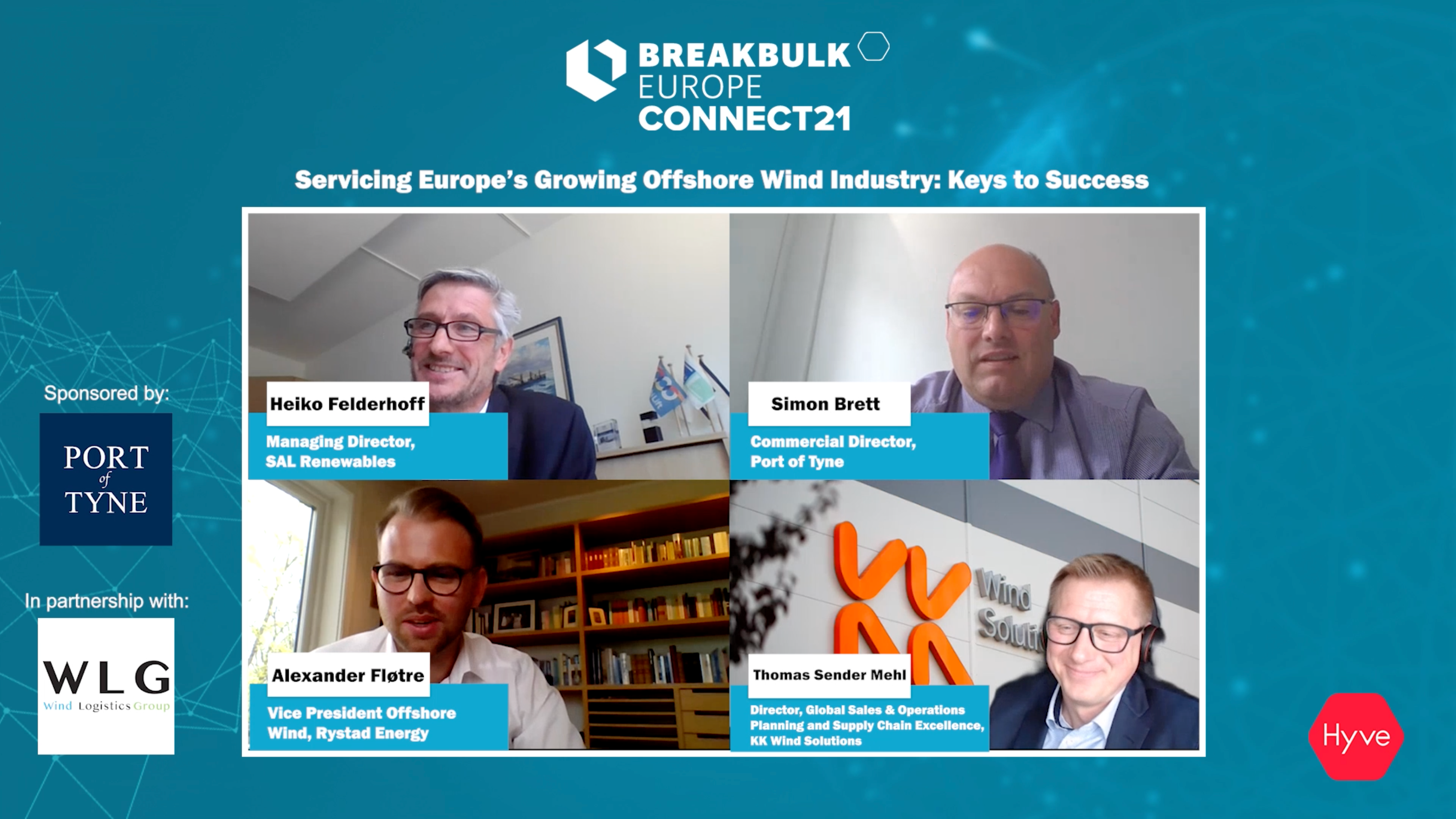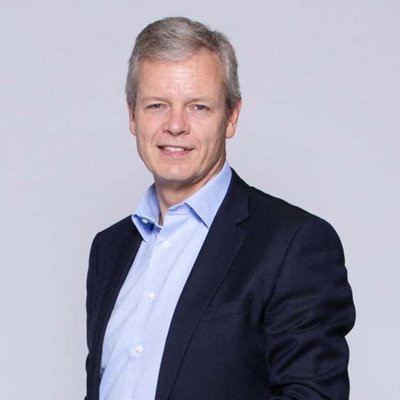May 24 | 2021
Is Supply Chain Ready for Rapid Offshore Wind Buildup?

By Gary Burrows
Given that Europe’s offshore wind capacity is projected to increase four-fold by the end of the decade, is the industry ready for such a rapid ramp-up?
That’s the question that was posed to industry executives who focus on offshore wind during a May 20 Breakbulk Europe Connect21 session, Servicing Europe’s Growing Offshore Wind Industry: Keys to Success.
Facing such a major supply chain capacity crunch, session panelists stressed that players – from original equipment manufacturers and engineering, procurement and construction companies, to ports, carriers, installation vessel operators and other key parties – need to collaborate and set priorities to utilize and effectively grow existing capacity to deliver such ambitious goals in Europe and other burgeoning global offshore markets.
‘Flood of Projects’
Rystad Energy projects the European offshore wind market will more than double to 52 gigawatts, or GW, by 2025, nearly 33 GW of added capacity from the 24.3 GW in operation in 2020, said Alexander Fløtre, vice president offshore wind. The energy research and intelligence firm sees a further doubling of capacity by 2030 to more than 115 GW.
“It’s a rapid ramp-up where the more established countries such as the UK and Germany are setting ambitious targets, and newcomers such as France and Poland are joining the race,” Fløtre said. He noted other countries such as Denmark are also planning large hubs of additional capacity.
This “flood of projects” will begin to come online starting in 2024 and building through 2030 and perhaps beyond, said Simon Brett, commercial director, Port of Tyne. Despite setting lofty offshore goals, most European markets got off to a slow start and will have to pick up the slack by the end of the decade.
“You’re going to have projects in the UK, Belgium, Holland, Germany, Denmark all coming together at the same time, then there’s going to be massive demand for Tier 1 installation companies and facilities,” he said.
Plenty of Bottlenecks
“I think nobody’s ever thought about the sequencing of these projects,” Brett continued. “Everybody wants their projects installed at the same time, and that’s where the challenge is going to come.”
Those ports that can handle the projects still face limited capacity, he said. “If you look at the East Coast of the UK, you’ve got probably five or six ports at most that can take the largest installation craft, and each one wants its own Tier 1 supplier. Who’s going to take priority?”
With projects facing such long lead times – anywhere from six months to three years – there are plenty of bottlenecks.
“Some of these (windmill components) are produced in the Far East or Vietnam and they’re simply parked up in different ports that are trying to shift around,” said Thomas Sender Mehl, global sales and operations planning and supply chain excellence, KK Wind Solutions.
Throw into the mix that original equipment manufacturers, or OEMs, are increasing development times and increasingly developing new and larger turbine types and blade lengths, which further complicates adjusting supply chains to meet demand, Sender Mehl said.
“There are few newbuilds that can handle the largest components that we expect,” Fløtre said, with 14 to 15 megawatt turbines being developed by Gamesa, GE with its Haliade-X, and MHI-Vestas.
“It’s a competitive advantage for the OEMs right now. Who’s the best at beating the others,” said KK Wind Solutions’s Sender Mehl. He added that the OEMs are bidding on “giga-deals where the turbines are not even specified. It’s just a number they commit to.”
It's a challenge to “future proof the infrastructure that’s required,” agreed Port of Tyne’s Brett. As it can take as much as three years to build infrastructure, such long-range plans must be scheduled to integrate with other projects, particularly in the current bustling offshore development.
Collaboration
To resolve the industry’s constraints, panelists called for a bringing together of the collective elements of the supply chain to collaborate on solutions.
That begins with governments having the “political willingness” to address issues that are largely based on their ambitious – though environmentally necessary – offshore goals,” Sender Mehl said. This would include permitting, laying groundwork for port and storage capacities and, for markets such as the U.S. East Coast, thinking more regionally than the current state-by-state or even community-by-community focus.
Port of Tyne’s Brett noted that as pan-European governments’ require reducing offshore wind costs, their demand for ever-larger projects requires the need for investment in expensive infrastructure and service vessels, cranes and equipment. “It’s a vicious cycle,” he added.
The “operational industry” must also be part of the collaborative solution, he noted. For example, OEMs flattening out production to match supply chain capacity, and setting priorities for projects, rather than trying to jam multiple projects through, he said.
Panelists agreed one of the largest problems is failing to “sign the contract earlier,” Heiko Felderhoff, managing director of SAL Renewables, said bluntly. “It starts with a signature that we can start our activities, right? And that goes down the line, as simple as that.”
Instead, Sender Mehl said the OEMs should “look into end-to-end solutions for the operators and owners, because then it would be easier to execute the project. If you have the same interfaces, the same lifting points, you can utilize equipment. But it takes an effort from the OEMs.
“I think Vestas has over 1,000 engineers. It’s the same for Siemens, Vestas, GE, everybody. It’s not a lack of brainpower, is just a willingness to share with the industry.”
Working earlier can lead to cost reductions – especially with the OEM’s own operational costs, he added.
A further obstacle is the true sharability of supplier portals, Brett said. He noted that the Association for Supply Chain in the North East of England commissioned a survey that found that portals can be an obstacle to better engagement.
“It’s OK if you’re providing electrician services … but it’s a very, very difficult way to engage with an OEM or a developer when you’re talking about installation craft and port facilities. These are far more strategic things that need to be discussed,” he argued.
Global Markets
Beyond Europe, offshore wind markets are bursting in China and the wider Asia-Pacific, as well as in the U.S. and other regions, further stretching existing capacity.
“Our ships are full, full, full of wind turbines and blades and stuff going to the Far East right now,” SAL Renewables’ Felderhoff said. “So, we are fully booked and rates are going in only one direction: up.”
As far as installation ships are concerned, “there are not many units in the world,” he said. “You can count on one hand those which are able to handle this stuff. It’s really challenging.”
SAL Renewables has acquired a U.S.-flag installation crane ship with 10,000 tonnes of lift, he said.
Despite the positive offshore business prospects, constrained ship capacity and a limited fleet of installation vessels – and limited capacities to handle ever-growing components – there is little evidence of newbuilding, he added.
While some have suggested using oil & gas installation vessels, the panelists questioned whether they were fit for the unique purpose of offshore wind installations, which require quick, multiple positionings for a windfarm.
“The wind turbine installation, and also maintenance, is quite special, and you need sophisticated or specially designed tonnage for it, so I don’t see them being a big help,” Felderhoff said. “For foundations, it’s a bit different, as there you can use big floating cranes. But once it goes to the tower and up to the nacelle and blades, I don’t see it.”
Aftermarket Prospects
Felderhoff, of SAL Renewables, a carrier unit of Harren & Partner Group, expects the operations and maintenance, or O&M, and repowering sides of the wind business to be a growing aftermarket component of offshore wind energy.
“Most are focusing on the new markets, and we are going now for the aftermarket and offering full-fledged maintenance services including repowering after the life cycle of the parks,” Felderhoff said. Efforts range from component exchange, overhauling parts and providing a new warranty and reinstalling or upgrading existing farms.
“This has huge potential in the North Sea-Baltic Sea area here in the North, and that’s what we’re focusing on,” he added.
Sender Mehl said that, along with repowering and service, he’s seeing a growing trend among OEMs of outsourcing much of what they would normally do themselves to companies such as his.
“They actually give us full power and are outsourcing a lot of the assembly and service parts,” said Sender Mehl. “It’s really a sign of trust between our biggest customers and that all comes from the OEMs.
In his previously role at Vestas, he noted that the OEM actively sought to collaborate in developing the U.S. market by locating a factory there in Colorado.
From the shipping perspective, he spoke with the Danish ambassador in the U.S, meeting up in Port Houston, demonstrating willingness to collaborate. “They said, what do we need to do to comply with this offshore market? How does it work? How can we get that knowledge?’”
The company also worked through shipping company Martin Bencher, which used its experience and “guys on the ground” to find the right vendors and service partners.
“It was quite some months over there (U.S.), but we actually came up with a good solution and the right spot for the factory from the industry and political guys. It was quite exhausting to do, but now we see the benefit of it.”




